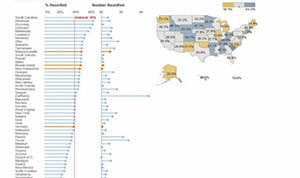Developing a Data-Driven ACF Workforce
Executive Summary
 Regional child welfare program specialists work closely with states and tribes to improve services to children and their families in the child welfare system. One area that has become increasingly more critical to their work is using data to identify, explore, and better understand state performance in child welfare outcomes. This task requires easy access to intuitive and relevant data, knowledge and understanding of key outcomes and data sets, and analytic skills.
Regional child welfare program specialists work closely with states and tribes to improve services to children and their families in the child welfare system. One area that has become increasingly more critical to their work is using data to identify, explore, and better understand state performance in child welfare outcomes. This task requires easy access to intuitive and relevant data, knowledge and understanding of key outcomes and data sets, and analytic skills.
However, the way we typically present and report on data to child welfare staff is cumbersome and difficult to digest. For example, the most prominent data report for staff, the Children and Family Services Review Data Profile, is presented in a Word document consisting of 16 pages of text, 25 footnotes, and tables with almost 700 individual cells of data. Further, trainings offered to staff seeking to better understand the data tend to be provided in one or two-hour blocks of time via webinar format and are not recorded for later viewing. Regional office staff overwhelmingly reported in our baseline survey that this training format is not conducive to increasing their understanding and use of data.
Our HHS Ignite project set out to test out a more intuitive way to present our data – a way that allows users to quickly see trends and areas needing improvement. Using an agile development approach and bi-weekly feedback from a Steering Committee composed of regional and central office staff, we used Tableau software to create a data tool that was intuitive, easy to use, and allowed staff the flexibility to drill down into the data and analyze performance by geographic dimensions and various child characteristics. Equipped with this information, staff can make more informed decision and recommendations. In fact, 100% of survey respondents said that this new data tool would be useful in their work. In addition, they indicated that the tool would make it easier to do their job, increase their productivity, and make it easier for them to make connections between data and child welfare practice. Many expressed eagerness to have the tool available for everyday use.
In the second part of our project, we created two short videos. The first video was an introduction to our project that provided basic information and context. The second video was a short, focused training video. The training video walks the user through the data tool functionality while building on a common scenario they face in their everyday work with state child welfare agencies. As a result, the video helps staff understand how to use the new tool itself, as well as how to better understand and use the data. Regional staff also reported that the video tutorial was easy to use, helped them better understand how to use the new tool, and was an effective training method.
A project supported by the: HHS Ignite Accelerator
Team Members
Heather Swope (Project Lead), ACF
Valeria Fajardo, ACF
Kurt Heisler, ACF
Melinda Baldwin, ACF
Paul Kirisitz, ACF
Milestones
July 2013: Selected into the HHS Ignite Accelerator
August 2013: Time in the Accelerator began
February 2014: Time in the Accelerator ended
Project Sponsor
Brett Brown, Social Science Research Analyst, Administration for Children, Youth & Families, ACF


